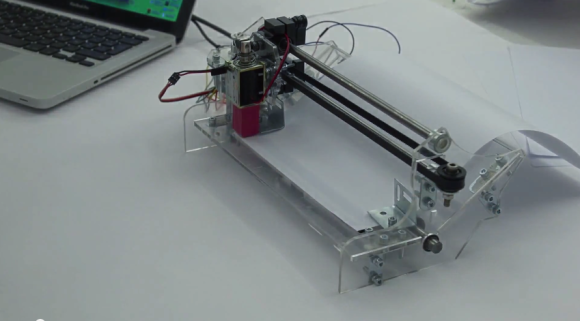
[Benjamin] is just putting the finishing touches on his home-made, paper-stabbing, needle-printer!?
From a distance, it looks like the bare bones of a regular inkjet printer, but it’s not. Instead of an ink-head it features a needle — It’s kind of like a dot-matrix (hole-matrix?) printer. He’s using it for silk-screening masks, which we have to admit, must be pretty handy — it certainly makes soldering SMT’s less scary! It could also be used for embossing or even braille printing.
The frame of the printer is laser cut out of clear plastic, and two Nema 17 steppers drive the X & Y axes. A simple solenoid actuator provides the needle-stabby action. He’s controlling the whole thing using an Arduino, and sending the data to it using a call-and-response protocol to avoid any data losses. It was built for just shy of $200, which was his original goal for the project.
Check it out after the break!














That would produce nice candle shield too
next step –
Create ink-to-needle system
Advertise as dot-matrix tatoo printer
….????….
profit
You beat me to it. Was thinking tattoo printer, too.
http://blog.ponoko.com/2011/03/17/automatic-cnc-tattoo-machine/
Dot matrix tattoo printer … Hmm, too much concentration camp associations for my taste. It is something a dystopian government would use to permanently mark us all, fast, with high readability, and probably using automatons, not human henchmen.
Well, as a friend of someone who’s mother was a political prisoner for three years in occupied Poland, i try not to think that way. I was leaning more towards making money off of the hipster scene – they seem to enjoy their tattoos, and also retro things, and i’m sure dot matrix fits that…
Hm, maybe just sharpen an old 9-pin Epson printer.
Actually… if you could get a tattoo done in 2 seconds, even 2 seconds of searing pain, there’d probably be a market in that. The lack of accuracy and reliability would by default become part of the “art”.
Are you sure he’s using it for silkscreening, it dosen’t look like itwould be remotely fine enough.
First- this is potentially able to redefine several basic applications of needlework. WELL done!
Secondly: Silkscreening is a “Categorical” term that is commonly used to cover many processes where ink is forced through a stencil.
In a separate category- the reality of folks needing Braille is sobering and this Hack might Do Very Good Things for people.
Sometimes a Hack serves us above it’s other utilities as that which HACKS PERCEPTIONS.
Braille printers are way expensive,
a 3d printed version of this laser cut project would be awsome.
I’m fairly sure it’s silkscreening for t-shirts, etc not solder paste.
Yes it’s for silkscreening as in serigraph printing for posters and t-shirt, using tracing paper instead of machine paper. Indeed I don’t think using it for solder paste would work with the actual setup.
Using it for solder paste “as is” depends on what component pitch you are designing for from my reading of the build. Tools are what they are unless we alter them… That said, many PCB fabrication steps could indeed work on one of these.
Great choice of first print.
#OMG, I did the same thing using LEGO bricks some 5 years ago… but his thingy is quite faster.
http://hackaday.com/2008/08/15/plotter-made-entirely-from-lego/
How about using a larger blunt needle and printing braille?
needle-stabby action
Didn’t they just release their 2nd cd?
I wonder if the same sort of actuator a hard drive’s head uses (voice coil? Is that right?) would provide better needle-stabby action. Not to say this needle-stabby action is insufficiently stabby, but stabbier oftentimes seems like a worthy goal.
Reminds me of Thomas Edison’s electric pen. Both devices are intended for making stencils. The difference is that Edison’s was hand held and used a rotary motor to reciprocate the needle.
No sound in the video ? Disappointing.
here you go:
https://www.youtube.com/watch?v=Z7KIcwAn0FU
A great deal of work was done on ideal dithering for dot pictures in the days of dot matrix (wasn’t she in Spaceballs?) and early laser printers. There are some blue noise dithers that give fine results with no geometric pattern and you can fit them to the constraints you need for minimum distance between dots (holes). Robert Ulichney wrote a book showing his results of researching and testing and gave algorithms for the best results. There is rather poor PDF that has some of the results from the book. http://www.hpl.hp.com/research/isl/halftoning/publications/DitheringWithBlue.pdf the book is still a good read “Digital Halftoning”. The blue noise dither got him a job at HP Labs. Get a used one off Amazon.
Great reference thanks! I will definitely read that! Right now I’m using this really simple matrix of point to avoid damaging the paper too much (the svg version of the program totally torn the paper apart because points were too close) but your reference could help me get better results!
(On other subject, sorry about the lack of sound, the only cam my school would lend had no sound input, and the Edison mechanical pen was indeed part of my inspiration)